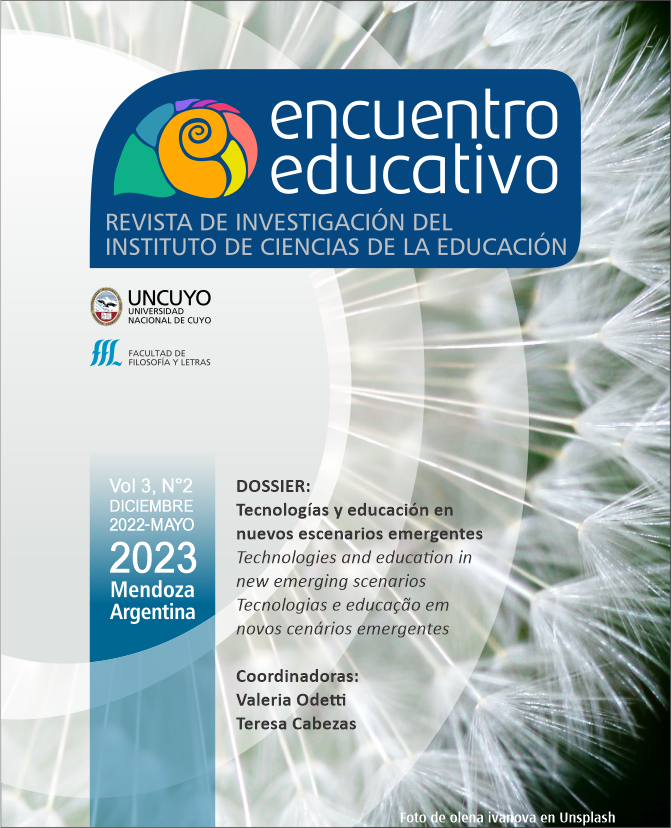Designing escape games: convergence between narrative, didactic and technology
Keywords:
narrative universe, immersion, performance, online education, gamificationAbstract
Digital narratives have gained popularity in technology-mediated educational proposals, both in the design of hypermedia and transmedia materials, as in the configuration of immersive and performative environments. Currently, one of the most popular formats is the escape game. This paper analyzes the design of the educational escape game ‘Lost in 2050’, created for the workshop ‘Escape games in education’ of the Usina of Experiencias form Education and New Technologies Project of the Latin American Faculty of Social Sciences (in Argentina). Design decisions evidence was given from the formats in which narrative was constructed; the way in which immersion was propitiated and how this process is sustained during the game experience; the underlying didactic in the approach of the content and the tasks proposed by the challenges; and finally, the technological configurations on the basis of the navigation diagram of the educational escape game.
The theoretical approach of the analysis recovers the concept of educational escape game and the particularity of its design, which is related to the pertinent didactic decisions that allow a group of target people to acquire knowledge from a playful and collaborative learning experience. This paper develops conceptual precisions concerning the three structuring elements of any educational escape game design: the narrative universe, the didactic decisions and the technological
configurations.
References
Barberá, E. y Badía, A. (2004). Educar con aulas virtuales. Machado Libros.
Gee, J. (2008). Learning and Games. En Salen, K. (Ed.) The Ecology of Games: Connecting Youth, Games, and Learning. The John D. and Catherine T. MacArthur Foundation Series on Digital Media and Learning. The MIT Press. 21–40. https://doi.org/10.1162%2fdmal.9780262693646.021
Gee, J. P. (14-15 de agosto de 2006). Are Video Games Good for Learning? [Texto de comunicación]. 13th National Conference, Curriculum Corporation. Adelaide, Australia. http://dx.doi.org/10.18261/ISSN1891-943X-2006-03-02
Gonzalez Tardón, C. (2010). Inmersión en mundos simulados. Definición, factores que lo provocan y un posible modelo de inmersión desde una perspectiva psicológica. Investigaciones Fenomenológicas, (2), 311-320. https://doi.org/10.5944/rif.2.2010.5590
Gros Salvat, B. (2011). Evolución y retos de la Educación virtual. Editorial UOC
Gros Salvat, B. (2014). Análisis de las prestaciones de los juegos digitales para la docencia universitaria. Revista Interuniversitaria de Formación del Profesorado, 28(1), 115-128.
https://www.redalyc.org/articulo.oa?id=27431190008
Hermann, A. (2015). Narrativas digitales como didácticas y estrategias de aprendizaje en los procesos de asimilación y retención del conocimiento. Sophia: colección de Filosofía de la Educación, (19)2. 253-270. https://doi.org/10.17163/soph.n19.2015.12
Kapp, K., Blair, L. y Mesch, R. (2013). The gamification of learning and instruction fieldbook: Theory into
practice. John Wiley & Sons.
Laddaga, R. (2006). Estéticas de la emergencia. La formación de otras culturas de las artes. Adriana Hidalgo
Editora.
Nicholson, S. (2016). Ask Why: Creating a Better Player Experience Through Environmental Storytelling and Consistency in Escape Room Design [Articulo de conferencia]. Meaningful Play, Lansing, Michigan.
http://scottnicholson.com/pubs/askwhy.pdf
Odetti, V. (2014). Materiales didácticos hipermediales: el caso del PENT FLACSO. 5 [Tesis de Maestría].
Universidad Nacional de San Martín.
Odetti, V. (2020). De lo hipermedial a lo performativo: el devenir de los materiales didácticos digitales. En J. García y S. García Cabezas (Comp.) Las tecnologías en (y para) la educación, (pp-87-99). FLACSO
Uruguay. https://publicaciones.flacso.edu.uy/index.php/edutic/article/view/5
Perkins, D. (1992). La escuela inteligente. Del adiestramiento de la memoria a la educación de la mente.
Editorial Gedisa.
Real Academia Española [@RAEinforma]. (28 de septiembre de 2015). #RAEconsultas El uso de «inmergir»
se documenta, entre otros, en autores como Ramón y Cajal o Pérez Galdós. [Tuit]. Twitter.
https://twitter.com/raeinforma/status/648450561776427008
Robin, B. (2016). The Power of Digital Storytelling to Support Teaching and Learning. Digital Education Review, 30, 17-29. https://files.eric.ed.gov/fulltext/EJ1125504.pdf
Taylor, D. (2015). Performance. Asunto Impreso Ediciones.
Veldkamp A., Van de Grint L., Knippels M. y Van Joolingen, W. (2020). Escape education: A systematic review on escape rooms in education. Educational Research Review, 31. https://doi.org/10.1016/j.edurev.2020.100364
Downloads
Published
How to Cite
Issue
Section
License
Copyright (c) 2022 Valeria Odetti, Milagros Langhi

This work is licensed under a Creative Commons Attribution-NonCommercial 4.0 International License.


















